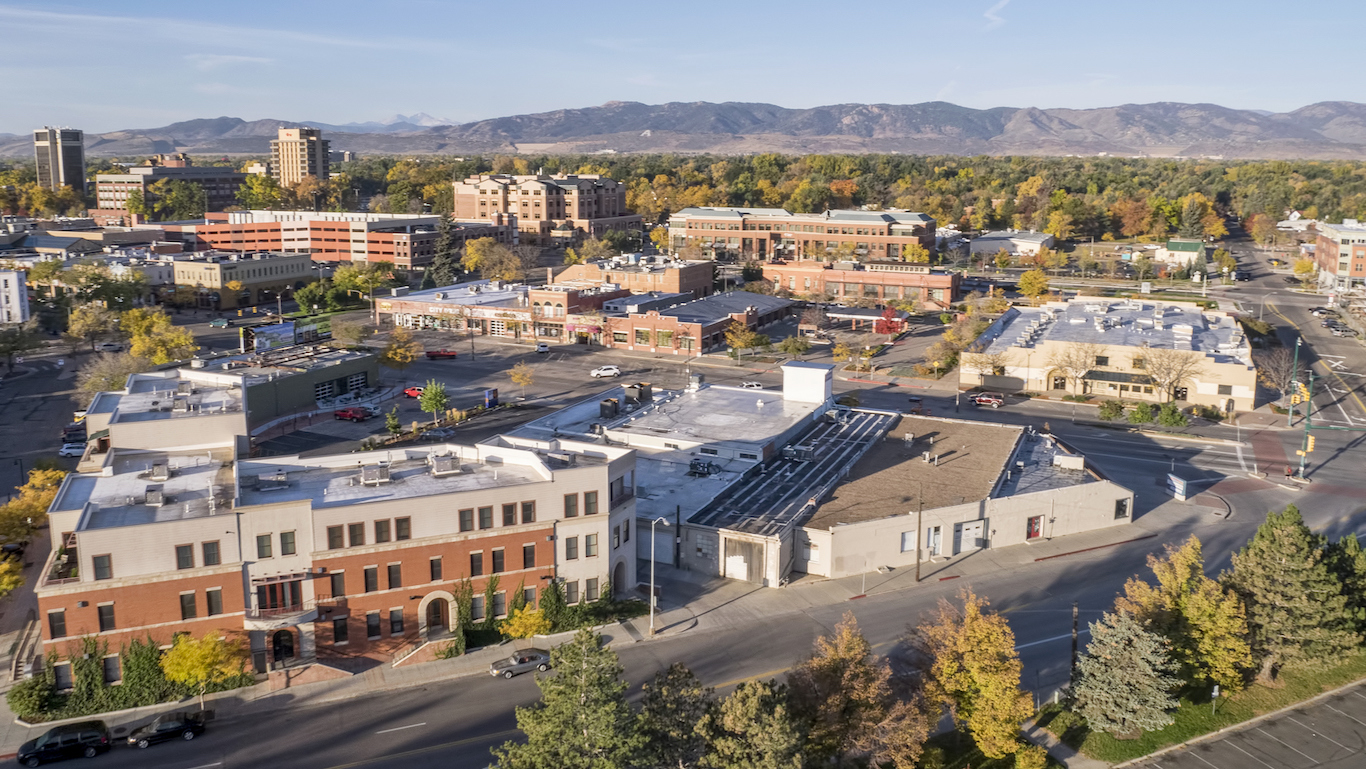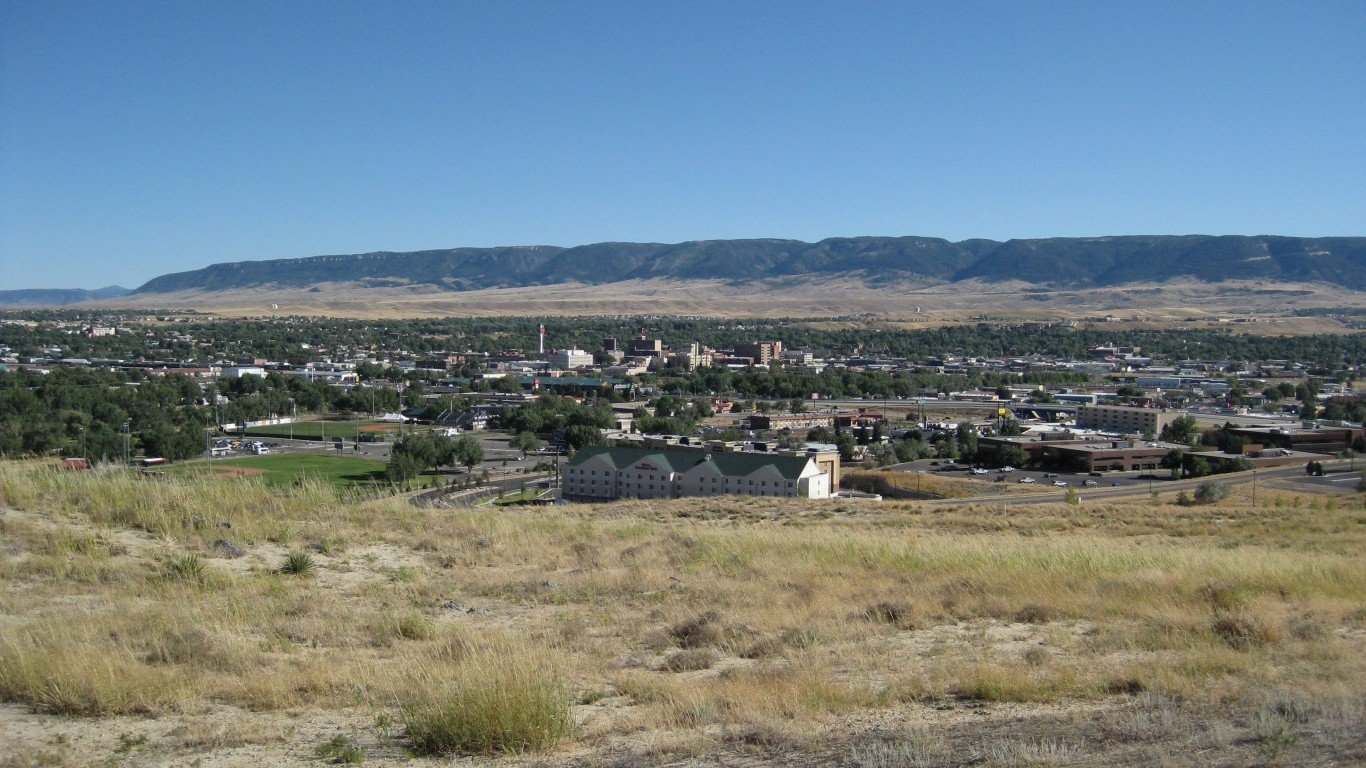Special Report
American Cities With Booming (and Shrinking) Incomes

Published:
Last Updated:

The American workforce earned 2.9% more income in 2014 than in the previous year. As the American economy continues to recover from the Great Recession, more people are able to find jobs. While total income has been rising nationwide, income did not rise uniformly across the country in 2014. In some U.S. metro areas, total income even declined.
To identify the metropolitan areas where total personal income rose or declined the fastest in 2014, 24/7 Wall St. reviewed recently released data from the Bureau of Economic Analysis. Odessa, Texas led the nation with an 8.1% increase in total income, while total income in Danville, Illinois fell by 3.9%, the largest drop of any metro area.
Total personal income is income earned by an area’s workforce. In many cities, therefore, a growing workforce was likely the primary reason for the rise in total income. A metropolitan area that had a greater number of salaried workers in 2014 compared to 2013 was far more likely to report higher total income than the year before. In 19 of the 25 cities where total income rose the most, the workforce grew at a faster pace than the national workforce.
Click here to see cities with booming incomes.
Click here to see the cities with shrinking incomes.
Similarly, all of the 25 metro areas where income grew slowly or declined had below-average or declining employment levels.
Nationwide, the industries that added the most employees to the income pool were the educational, health, and social services sector, the arts and entertainment sector, the professional and scientific sector, as well as the construction sector. In many cities where total income grew the fastest, these industries were largely responsible for the area’s employment growth.
While wages do not need to rise for the total income earned in a metropolitan area to increase, rising salaries were partially responsible for income growth in many cities. Personal income per capita increased at a faster pace than the national per capita income in all but one of the 25 cities with the fastest aggregate income growth. Per capita wages often increase when jobs are added in sectors that tend to pay more, such as the professional and scientific, information, and finance sectors. Metropolitan areas that add jobs in traditionally low-paying industries, including the manufacturing, retail, and transportation sectors, were more likely to have slower per capita income growth, or even declines.
Rising wages and a growing workforce are usually indications of economic prosperity, and certainly can be expected to lead to better outcomes down the road. However, the metro areas with rising total income include both strong economies with low unemployment, as well as weak economies with high jobless rates. Similarly, in close to half of the areas with above-average income, poverty was higher than the national rate.
To identify the cities where total personal income is rising the fastest, or is either rising the slowest or is declining, 24/7 Wall st. reviewed real personal income growth in 2014 for the nation’s 381 metropolitan statistical areas from the Bureau of Economic Analysis. Real personal income and per capita income also came from the BEA. The share of an MSA’s workforce employed by a given industry came from the U.S. Census Bureau’s 2014 American Community Survey. Population growth, median household income, poverty rates, and homeownership rates also came from the U.S. Census Bureau’s 2014 American Community Survey. Unemployment rates came from the BLS. All data are for 2013 and 2014 unless otherwise specified.
These are the cities where income is growing the fastest and slowest.

25. Panama City, FL
> Personal income growth (2013-2014): 4.8%
> Per capita personal income: $36,459
> May unemployment rate: 4.7%
> Employment chg.: 3.0%
Total income in the Panama City metro area increased by 4.8% in 2014, significantly faster than the 2.9% national income growth rate. A significant increase in wage earners in the metro area helped drive up Panama City’s aggregate personal income. Employment in the metropolitan area increased by 3% in 2014, somewhat faster than the national growth in nonfarm employment of 1.9%. Employment in the information sector, which often pays higher than average salaries, grew by 35.6% in 2014, far more than the 23.0% nationwide sector employment growth rate over the same period.

24. San Francisco-Oakland-Hayward, CA
> Personal income growth (2013-2014): 4.8%
> Per capita personal income: $54,893
> May unemployment rate: 3.7%
> Employment chg.: 3.3%
In some cities, rising income can be largely attributed to a growing workforce as earners are added to the income pool. This was the case in the San Francisco-Oakland-Hayward metro area, where employment increased by 3.3%, compared to a national increase of 1.9%. The area’s agriculture, forestry, fishing and hunting, and mining sector was one of the largest drivers of labor force growth in the area. Employment in the sector grew by 31.9% in 2014, more than the 23.0% the nationwide industry employment growth rate over the same period.

23. Austin-Round Rock, TX
> Personal income growth (2013-2014): 4.8%
> Per capita personal income: $43,715
> May unemployment rate: 3.1%
> Employment chg.: 4.5%
Total income in the Austin-Round Rock metro area increased by 4.8% in 2014 versus 2.9% national growth rate. Austin-Round Rock’s population has grown rapidly in recent years, a good sign for the economy. The number of workers in the city grew by 3.3% in 2014, one of the faster such growths in the country. Austin-Round Rock’s unemployment rate fell from 5.1% in 2013 to 4.2% in 2014, one of the larger improvements in the country. In May of this year, just 3.1% of the workforce was unemployed, one of the lowest jobless rates of any metro area.
The professional and scientific sector was one of Austin-Round Rock’s largest growth areas. In 2014, the number of area workers employed in the sector grew by 6.2%, more than double the nation’s growth in these jobs.

22. Elkhart-Goshen, IN
> Personal income growth (2013-2014): 4.9%
> Per capita personal income: $37,771
> May unemployment rate: 3.8%
> Employment chg.: 4.0%
An expanding workforce drove personal income growth in Elkhart-Goshen. Elkhart-Goshen’s unemployment rate fell from 7.2% in 2013 to 5.1% in 2014, one of the biggest improvements of any metro area in the country. During that time, employment in the city grew by 4.0%, a rapid pace compared to the 1.9% national growth rate.
Employment in the retail trade and transportation and warehousing, and utilities sectors declined in 2014. However, employment in the agriculture, forestry, and mining sector, as well as in the professional, scientific, and management sectors more than made up for those income losses. The number of area workers employed by the two sectors grew by 69.5% and 26.6%, respectively, in 2014.

21. Gainesville, GA
> Personal income growth (2013-2014): 4.9%
> Per capita personal income: $36,714
> May unemployment rate: 4.1%
> Employment chg.: 3.2%
A significant part of Gainesville’s increased income may have come from the metro area’s arts and entertainment sector. Employment in the industry increased 18.6% in 2014, while national employment in the sector grew by 3.7%. As total income grew in Gainesville, the area’s poverty rate declined. The metro area’s poverty rate fell from 21.9% in 2013 to 16.6% in 2014, the second-largest such improvement in the country.

20. Kahului-Wailuku-Lahaina, HI
> Personal income growth (2013-2014): 5.0%
> Per capita personal income: $34,188
> May unemployment rate: 3.4%
> Employment chg.: 2.1%
As in most metro areas with booming total income, personal income growth in Kahului-Wailuku-Lahaina can be attributed to a combination of rising wages and more wage earners. Employment in the city increased by 2.2%, while employment nationwide increased by 1.9%. Per capita income increased by 3.5% in 2014, versus the nation’s 2.2% per capita income growth.

19. Houston-The Woodlands-Sugar Land, TX
> Personal income growth (2013-2014): 5.0%
> Per capita personal income: $50,288
> May unemployment rate: 5.0%
> Employment chg.: 3.5%
Total income in the Houston-The Woodlands-Sugar Land metro area, one of the nation’s largest urban regions, increased by 5.0% in 2014, faster than the 2.9% national growth rate. Except for the information and manufacturing sectors, every industry in the area added jobs in 2014. Notably, employment in the agriculture, forestry, fishing and hunting, and mining sector increased by 17,596 workers, or 15.4%. Nationwide, the sector grew by just 2.3%. The construction sector added more jobs than any other sector, with the workforce growing adding 22,522 employees.
Not only are earners being added to the income pool, but per capita income also appears to be rising. Income per capita in Houston-The Woodlands-Sugar Land increased from $49,068 in 2013 to $50,288 in 2014.

18. Bend-Redmond, OR
> Personal income growth (2013-2014): 5.0%
> Per capita personal income: $40,012
> May unemployment rate: 4.5%
> Employment chg.: 6.1%
Bend-Redmond’s rising income was supported by rapid population growth, and workforce growth along with it. The workforce in the city grew by 6.1% in 2014, the fourth fastest employment growth rate of any metro area. The educational services and health care sector was one of the largest drivers of labor force growth in the area. Employment in the sector grew by more than 50% in 2014, while national employment in the sector increased by just 1.9%.

17. Fort Collins, CO
> Personal income growth (2013-2014): 5.0%
> Per capita personal income: $39,557
> May unemployment rate: 3.1%
> Employment chg.: 3.4%
Total personal income in the Fort Collins metro area increased by 5.0% in 2014 despite employment decline in the area’s manufacturing sector. The sector employed nearly 2,000 fewer workers in 2014, a 13.1% drop. Still, the city’s income growth was faster than the 2.9% national growth rate. A significant part of Fort Collins’s increased earnings likely came from the metro area’s information sector. The number of people employed in the industry increased by 34.5% in 2014.

16. Pueblo, CO
> Personal income growth (2013-2014): 5.0%
> Per capita personal income: $33,573
> May unemployment rate: 5.3%
> Employment chg.: 1.5%
Income in the Pueblo metro area increased by 5.0% in 2014, trailing just 15 other metro areas in total income growth. The income growth was likely the result of an expanding labor force. The professional services sector — which tends to pay higher salaries — was one of the largest drivers of employment growth in the area. The sector added nearly 1,800 jobs in 2014, a 41.1% increase and well above the 2.5% national sector growth.

15. Las Vegas-Henderson-Paradise, NV
> Personal income growth (2013-2014): 5.1%
> Per capita personal income: $36,858
> May unemployment rate: 6.5%
> Employment chg.: 4.1%
Every industry in the Las Vegas area except for public administration and miscellaneous services added jobs in 2014. The metro area’s largest sectors — the arts, entertainment, recreation, and accommodation and food services sector, which employs more than one-quarter of the workforce — added 12,283 jobs, by far the largest employment growth of any sector in the area. Between growth in the entertainment industry, as well as other sectors, total employment in the area increased by 4.1%, one of the fastest increases in the workforce of any metro area. This increase of wage earners contributed to the area’s total income growth.

14. College Station-Bryan, TX
> Personal income growth (2013-2014): 5.1%
> Per capita personal income: $33,374
> May unemployment rate: 3.5%
> Employment chg.: 2.9%
Incomes in the College Station-Bryan metro area increased by 5.1% in 2014, faster than the 2.9% national growth rate. Home to a number of universities, the bulk of income gains in College Station came from the education and health services sector in 2014. The sector, which employs 31.9% of the area’s workforce, added 3,628 jobs that year, an 11.1% increase. As the total number of wage earners increased, per capita income grew as well, from $32,365 to $33,374.

13. Visalia-Porterville, CA
> Personal income growth (2013-2014): 5.1%
> Per capita personal income: $33,998
> May unemployment rate: 10.7%
> Employment chg.: 1.1%
Income in the Visalia-Porterville metro area increased by 5.1% in 2014, much faster than the 2.9% national growth rate. Agriculture is a major part of the area’s economy. Tulare County, which contains Visalia, boasts more agricultural production than any other U.S. county. Milk production alone was worth more than $2.5 billion in 2014. The sector employs 22.2% of the area’s workforce, 10 times the share of the sector employs nationally and the largest such share of any metro area. Adding 7,880 jobs, industry employment grew by 25.3% in 2014. This growth likely helped drive the income gain.
However, employment in the metro area across all sectors actually increased by just 1.1%, meaning the bulk of Visalia’s total income growth came from a rise in the typical wage. Per capita personal income in the area increased by 4.3% in 2014, compared to a 2.2% national increase.

12. Vallejo-Fairfield, CA
> Personal income growth (2013-2014): 5.2%
> Per capita personal income: $33,544
> May unemployment rate: 5.3%
> Employment chg.: 2.4%
Like in many other metros across the nation, Vallejo-Fairfield manufacturing companies are shedding jobs. The industry employed 2,846 fewer workers in the area by the end of 2014, a 15.1% decline. Other industries in Vallejo-Fairfield are flourishing, however, and are driving income growth. The retail trade sector, for example, added 4,538 jobs, which while likely are not as high paying jobs as in other sectors, contributed substantially to the income pool.

11. Casper, WY
> Personal income growth (2013-2014): 5.2%
> Per capita personal income: $56,274
> May unemployment rate: 7.6%
> Employment chg.: 1.7%
Casper’s information industry only employs 1.2% of the area’s workforce. However, the number of workers employed in the industry grew in 2014 by 159.9%, among the largest such growth rates of any metro information industry. Not only did total personal income grew in Casper, but also per capita income, from $53,793 in 2013 to $56,274 in 2014. Residents with rising incomes are more likely to be able to afford homes, and the per capita income growth likely explains the rise in homeownership in Casper. The share of area householders who own their homes grew from 67.9% in 2013 to 62.9% in 2014, one of the largest such increases nationwide.

10. Carson City, NV
> Personal income growth (2013-2014): 5.3%
> Per capita personal income: $39,401
> May unemployment rate: 6.8%
> Employment chg.: 0.7%
Total income in the Carson City metro area grew by 5.3% in 2014, the 10th fastest growth nationwide. The area’s educational and health services industry grew by 78.8%, with roughly 2,200 jobs added. This growth was the largest, proportionally, of any metro area’s education sector, and since the industry employs a sizable 20.6% of Carson City’s workforce, the job growth added considerably more earners to the income pool.

9. Mount Vernon-Anacortes, WA
> Personal income growth (2013-2014): 5.3%
> Per capita personal income: $40,509
> May unemployment rate: 6.5%
> Employment chg.: 2.6%
Income in the Mount Vernon-Anacortes metro area grew 5.3% in 2014, the ninth fastest growth rate nationwide. The area’s professional, scientific, and management sector, which tends to pay better than most other sectors, added jobs, and likely a substantial amount to the income pool. Employment in the industry increased 45.4% in 2014, in stark contrast with the 2.5% nationwide professional sector growth rate in 2014. Employment levels in the area’s agriculture, forestry, fishing and hunting, and mining sector, as well as in the construction sector, also grew considerably, each adding well over 1,000 jobs.

8. Yakima, WA
> Personal income growth (2013-2014): 5.4%
> Per capita personal income: $36,467
> May unemployment rate: 7.7%
> Employment chg.: 1.3%
Total personal income in the Yakima metro area increased by 5.4% in 2014. Agriculture is at the heart of Yakima’s economy, employing 17.8% of the workforce — the fourth highest proportion compared with other cities and considerably higher than the national proportion of 2.0%. The sector added 2,770 jobs in 2014, a 17.8% increase. Part of Yakima’s increased total income may also have come from the metro area’s information sector. Employment in the generally high-paying sector increased 23.9% in 2014 from 2013.

7. Lake Charles, LA
> Personal income growth (2013-2014): 5.4%
> Per capita personal income: $41,346
> May unemployment rate: 4.9%
> Employment chg.: 5.4%
Personal income in Lake Charles rose as a result of an expanding workforce and rising wages. Lake Charles’s rising total income was supported by rapid job growth. The city’s workforce grew by 5.4% in 2014, one of the fastest growth rates of any metro area. Employment in agriculture, forestry, fishing and hunting, and mining sector increased 59.6% in 2014, contributing to the income growth. In addition to the number of salaried workers growing in the area, typical wages appear to have risen in Lake Charles as well. Personal income per capita in the metro area increased from $39,489 to $41,346.

6. Beaumont-Port Arthur, TX
> Personal income growth (2013-2014): 5.6%
> Per capita personal income: $40,500
> May unemployment rate: 6.4%
> Employment chg.: 2.8%
Employment levels in a number of industries in the Beaumont-Port Arthur metro declined in 2014, unusual for a metro area with top total income growth. Wholesale trade, retail trade, as well as the traditionally high-paying finance and professional, scientific, and management industries each shed more than 10% of jobs.
Offsetting these declines, the Beaumont area’s manufacturing sector employment grew by 44.6%. The information sector was also one of the largest drivers of employment growth in the area. Employment in the sector grew by 44.6% in 2014, more than the 23.0% nationwide industry employment growth rate over the same period.

5. Salem, OR
> Personal income growth (2013-2014): 5.8%
> Per capita personal income: $34,113
> May unemployment rate: 4.8%
> Employment chg.: 3.7%
While Salem residents are not especially wealthy, total personal income in the area increased by 5.8% in 2014, trailing only four other metros in income growth. Employment growth of 3.7% — well above the national employment level growth of 1.9% — largely accounts for the income added. While several industries shed jobs, employment increased at above average rates in the information, wholesale trade, and educational and health services sectors, more than offsetting the other sectors’ lost jobs.

4. Myrtle Beach-Conway-North Myrtle Beach, SC-NC
> Personal income growth (2013-2014): 6.0%
> Per capita personal income: $33,243
> May unemployment rate: 6.0%
> Employment chg.: 2.2%
Income in the Myrtle Beach-Conway-North Myrtle Beach metro area grew at a 6.0% pace in 2014, the fourth fastest growth rate nationwide. The generally higher-paying professional, scientific, and management, and administrative and waste management services sector was one of the largest drivers of employment growth in the area. Employment in the sector grew by 43.4% in 2014, more than the 9.8% nationwide industry employment growth rate over the same period.

3. Midland, TX
> Personal income growth (2013-2014): 7.0%
> Per capita personal income: $87,929
> May unemployment rate: 4.4%
> Employment chg.: 7.5%
Income growth in an area does not necessarily mean residents are well-off financially. However, Midland residents earn some of the highest incomes in the country. The area’s per capita income of $87,929 in 2014 was up considerably from 2013 and the highest of any U.S. metro area. The city’s employment grew by 7.5% in 2014, the second fastest growth rate in the country. The agriculture, forestry, fishing, hunting, and mining sector was one of the largest drivers of employment growth in the area. Employment in the sector grew by 24.7% in 2014, more than the 2.8% nationwide industry employment growth rate over the same period.
Midland’s unemployment rate fell from 3.6% in 2013 to 2.9% in 2014, one of the larger improvements in the country.

2. Hanford-Corcoran, CA
> Personal income growth (2013-2014): 7.0%
> Per capita personal income: $32,102
> May unemployment rate: 9.4%
> Employment chg.: 1.6%
Total personal income in the Hanford-Corcoran metro area increased by 7.0% in 2014, trailing just Odessa for the largest income growth in the country. Per capita income also grew substantially, from $29,875 in 2013 to $32,102 in 2014, a nation-leading 7.5% per capita income growth.
The information sector was one of the largest drivers of employment growth in the area. Employment in the sector more than doubled in 2014, a faster pace than the 23.0% nationwide industry employment growth rate over the same period. Employment in the finance and insurance industry, which tends to provide relatively high paying jobs, also grew considerably faster than the nationwide growth rate, at 43.6% versus 0.5% nationally.

1. Odessa, TX
> Personal income growth (2013-2014): 8.1%
> Per capita personal income: $44,859
> May unemployment rate: 6.4%
> Employment chg.: 6.1%
Odessa leads the nation in total personal income growth. As is often the case in places with booming incomes, Odessa’s population — and workforce — has been growing in recent years. The number of employed people in the city grew by 6.1% in 2014, the fifth fastest employment growth rate of any metro area. The traditionally high paying finance sector added 2,377 jobs to the income pool in 2014, increasing by 124.1%.
The income rise likely explains at least in part the area’s relatively low — and declining — poverty rate. The metro area’s poverty rate fell from 14.6% in 2013 to 10.0% in 2014, one of the largest such improvements in the country.

25. Watertown-Fort Drum, NY
> Personal income growth (2013-2014): 0.6%
> Per capita personal income: $40,689
> May unemployment rate: 5.8%
> Employment chg.: 0.5%
While income nationwide grew by 2.9% in 2014, total personal income in the Watertown-Fort Drum metro area increased by just 0.6%, one of the slowest growth rates of any metropolitan area. Watertown-Fort Drum’s workforce is growing very slowly. While the U.S. workforce grew by 1.9% in 2014, nonfarm employment in the metro workforce grew by just 0.5%. With the area’s economy highly dependent on Fort Drum military base, the metro was at risk of further economic drag during the 2014 federal military budget cuts. Of the 40,000 military positions that were nationwide, 28 were from Fort Drum.

24. Topeka, KS
> Personal income growth (2013-2014): 0.5%
> Per capita personal income: $41,734
> May unemployment rate: 4.0%
> Employment growth: 1.2%
Total income in Topeka grew by just 0.5%, even as national incomes increased by nearly 3%. The employed population grew slower than the nation’s workforce, 1.2% in Topeka versus 1.9% nationwide, which partially explains the modest income rise. Declining populations are a further indication of weak economic conditions, and while the national population grew by 0.8%, Topeka’s population shrank by 0.1%. The metro area’s incomes also likely suffered from lower employment in the construction and educational services industries, which each shed hundreds of jobs in 2014.

23. Sioux City, IA-NE-SD
> Personal income growth (2013-2014): 0.5%
> Per capita personal income: $45,675
> May unemployment rate: 3.3%
> Employment growth: 1.2%
Sioux City’s manufacturing sector grew by more than 1,400 jobs in 2014, likely adding to the area’s total income. However, the western Iowa metropolitan area lost hundreds of jobs in a number of industries, including in agriculture, finance, and construction. While the city’s population increased slightly, by 0.1%, its working-age population actually declined by 0.5%. The employed population grew by a below-average 1.2%, contributing to the tepid personal income growth.

22. Janesville-Beloit, WI
> Personal income growth (2013-2014): 0.5%
> Per capita personal income: $38,514
> May unemployment rate: 4.4%
> Employment growth: 1.4%
The manufacturing sector in the Janesville-Beloit metro area gained more than 2,000 jobs in 2014. The income added by these jobs was not enough to improve the tepid total income growth of 0.5%, however. The agriculture, forestry, fishing and hunting and mining industry as well as the area’s construction industry each recorded job losses for the year. Notably, employment levels in the traditionally high paying finance and insurance, as well as the professional and scientific sectors also declined.

21. Lawton, OK
> Personal income growth (2013-2014): 0.5%
> Per capita personal income: $37,723
> May unemployment rate: 4.6%
> Employment growth: 0.4%
In Lawton, Oklahoma, total income grew by just 0.5%, well below the national income growth of 2.9%. Income in a metro area is determined in part by changes in salaries. Incomes can also decline because there are fewer individuals earning incomes. While the employment levels nationally grew 1.9%, Lawton’s workforce increased by just 0.4%.

20. Carbondale-Marion, IL
> Personal income growth (2013-2014): 0.4%
> Per capita personal income: $39,422
> May unemployment rate: 6.7%
> Employment growth: 1.1%
While total income nationwide grew by 2.9% in 2014, income in the Carbondale-Marion metro area grew by just 0.4%. Fewer jobs in the area was one of the chief causes for the slow total personal income growth. The region’s manufacturing industry was one of the biggest drags on the region’s income, shedding more than 1,900 jobs in 2014, a roughly 35% decline in employment in the industry.

19. Mankato-North Mankato, MN
> Personal income growth (2013-2014): 0.4%
> Per capita personal income: $42,640
> May unemployment rate: 3.0%
> Employment growth: 0.7%
While total personal income nationwide grew by 2.9% in 2014, incomes in the Mankato-North Mankato metro area increased by just 0.4%. The relatively weak income growth may not reflect a poor economy, as the area’s unemployment rate of 3.0% is well below that of most U.S. metro areas. The jobless rate also declined in 2014.

18. Bloomsburg-Berwick, PA
> Personal income growth (2013-2014): 0.4%
> Per capita personal income: $39,759
> May unemployment rate: 5.4%
> Employment growth: -2.1%
Income in Bloomfield, Illinois grew by just 0.4%, about 1.5 percentage points below the national growth rate. Job losses largely account for the area’s weak income growth. The number of working adults in Bloomsburg-Berwick dropped by 2.1%, in stark contrast with the national workforce growth of 1.9%. Most of the decline came from job losses in the area’s construction industry, as well as the arts and entertainment industry. Each sector shed more than 1,000 jobs in 2014.

17. Springfield, IL
> Personal income growth (2013-2014): 0.3%
> Per capita personal income: $42,060
> May unemployment rate: 5.4%
> Employment growth: 1.4%
While the nation’s income grew by 2.9% in 2014, incomes in the Springfield metro area increased by just 0.3%. Slow income growth is often the result of slow slow growth or decline in the number of earners in a metropolitan area. While the number of people employed in the area actually increased by 1.4%, the area’s slow income growth may be explained by changes in the kinds of jobs. Employment in the generally low-income transportation industry grew by 37.6% in 2014, while higher-paying sectors such as the finance, information, and professional and scientific sectors either shed jobs or remained relatively stagnant.

16. Clarksville, TN-KY
> Personal income growth (2013-2014): 0.3%
> Per capita personal income: $38,545
> May unemployment rate: 4.7%
> Employment growth: 1.8%
Relatively slow income growth in the Clarksville area might be due to the significant changes in the composition of the labor force. The number of workers employed in a number of major industries, including the professional and scientific sectors, declined by more than 1,000, or by 25%. The area also added thousands of jobs in other sectors, including the arts, public administration, and retail sectors. Over the course of this shift, wages appear to have declined, as per capita personal income fell by 1.5%.

15. Jackson, TN
> Personal income growth (2013-2014): 0.3%
> Per capita personal income: $40,249
> May unemployment rate: 4.2%
> Employment growth: 1.6%
A loss of workers can result in a loss of income, but Jackson’s nonfarm employment increased roughly in line with the national growth, at 1.6% compared to a national growth rate of 1.9%. While the number of employees increased, the typical wages barely grew at all, increasing by just 0.7% compared to a national per capita income growth of 2.2%, resulting in an overall stagnant income growth.

14. Terre Haute, IN
> Personal income growth (2013-2014): 0.2%
> Per capita personal income: $35,189
> May unemployment rate: 5.8%
> Employment growth: 0.0%
While total personal income increased by 2.9% nationwide, Terre Haute’s total income remained effectively unchanged, growing by just 0.2%. This sluggish income growth can likely be explained by the lack of growth in the number of wage earners in the Indiana metropolitan area. National nonfarm employment increased by 1.8% in 2014, while Terre Haute’s remained unchanged.

13. Binghamton, NY
> Personal income growth (2013-2014): 0.1%
> Per capita personal income: $36,877
> May unemployment rate: 5.2%
> Employment growth: -1.5%
Binghamton is currently in a period of population decline. The population fell by 0.4%, and the number of working-age residents fell by 2.4% even as both figures rose on a national level. Similarly, the number of people employed in the area fell by 1.5% in 2014, largely accounting for the stagnant total income growth, at just 0.1%. By contrast, the national employment increased by 1.9%.

12. Albany, GA
> Personal income growth (2013-2014): 0.1%
> Per capita personal income: $36,923
> May unemployment rate: 6.0%
> Employment growth: 0.2%
A loss of income earners can be a drag on overall income growth. While the nation’s nonfarm employment grew by 1.9%, Albany’s employment increased by just 0.2%. The metro’s manufacturing sector shed more than 1,000 jobs in 2014. Albany’s finance and insurance sector, by contrast, gained 1,000 jobs. Still, the area’s per capita income in 2014 remained effectively unchanged, and total personal income in the area also barely increased that year.

11. Alexandria, LA
> Personal income growth (2013-2014): -0.4%
> Per capita personal income: $39,992
> May unemployment rate: 6.5%
> Employment growth: 0.6%
Alexandria is one of just 13 metropolitan areas where total personal income fell — even as the national total income rose by 2.9%. The number of income earners actually increased in the metro area, albeit by just 0.6%, which was a significantly slower rate than the national workforce growth rate of 1.9%. However, even as the number of wage earners increased, wages fell as per capita income decreased by 0.4%. Nationwide, per capita income rose by 2.2%. The per capita income decline might be partially explained by the lost professional and finance sectors jobs, which tend to be higher-paying.

10. Utica-Rome, NY
> Personal income growth (2013-2014): -0.4%
> Per capita personal income: $37,530
> May unemployment rate: 4.8%
> Employment growth: -0.7%
Income in the Utica-Rome metro area decreased by 0.4% in 2014, the 10th largest contraction nationwide. The number of people employed in the area fell by 0.7, which largely accounts for the total income drop. While the number of earners fell, wages appear to have remained stagnant as per capita income in Utica rose by just 0.1%. Nationwide, per capita income rose by 2.2%.

9. Grand Island, NE
> Personal income growth (2013-2014): -0.5%
> Per capita personal income: $43,891
> May unemployment rate: 3.4%
> Employment growth: -0.2%
While total income declined in Grand Island, the metropolitan area’s economy is by no means in poor shape compared to some of the other metros on this list. Grand Island’s unemployment rate of 3.4% is one of the lowest in the country, and while the area’s real personal income per capita decreased, at $43,891 it remains one of the higher incomes of any metropolitan area. Still, Grand Island’s workforce fell by 0.2% in 2014, while the number of people employed nationwide increased by 1.9%.

8. Kankakee, IL
> Personal income growth (2013-2014): -0.9%
> Per capita personal income: $33,132
> May unemployment rate: 7.1%
> Employment growth: 0.9%
Unlike many of the cities where total income fell in 2014, the number of employed workers earning incomes in Kankakee actually rose. Also, the metro area’s annual unemployment rate fell from 10.4% in 2013 to 7.9% in 2014, the fourth largest improvement nationwide. The income decline was likely the result of wage reductions. Per capita income fell slightly, by 0.1% in 2014.

7. Pine Bluff, AR
> Personal income growth (2013-2014): -0.9%
> Per capita personal income: $33,691
> May unemployment rate: 5.3%
> Employment growth: -3.1%
Total income in the Pine Bluff metro area decreased by 0.9% in 2014, the seventh largest contraction nationwide. Falling income in Pine Bluff was likely the result of fewer residents working. While U.S. employment grew by 1.9% in 2014, employment in Pine Bluff shrank by 3.1%, one of the largest drops of any U.S. metro area. The decline in employment was mostly concentrated among a few major industries. Employment in the wholesale trade, transportation, and arts and entertainment sectors each fell by more than 20%, shedding thousands of jobs, and accounted for a bulk of the area’s employment decline.

6. Yuma, AZ
> Personal income growth (2013-2014): -1.1%
> Per capita personal income: $28,342
> May unemployment rate: 18.7%
> Employment growth: 1.2%
Total income earned in Yuma fell by 1.1%, the sixth largest contraction nationwide. Even before the decline, Yuma’s economy was struggling. More than 25% of the Yuma workforce was out of work in 2013, the highest annual unemployment rate in the country. Yuma’s jobless rate fell to 22.9% in 2014, to second highest nationwide. Area residents are also not wealthy, with per capita income of $28,342, versus the national per capita income of $42,207. Workers may be settling for lower wages, as income per capita fell by 1.7%, the fourth largest such decline in 2014.

5. Peoria, IL
> Personal income growth (2013-2014): -1.1%
> Per capita personal income: $43,974
> May unemployment rate: 7.2%
> Employment growth: -0.4%
Total income in the Peoria metro area declined by 1.1% in 2014, the fifth largest such decline nationwide. Falling incomes in the Peoria metro area are partially due to fewer jobs at many of the area’s sectors. Employment declined in three of Peoria’s four largest sectors. Employment in educational services, health care, and social assistances, the metro area’s largest sector, fell by 6.4%, while nationwide the sector’s employment increased by 1.9%. Also, the manufacturing industry in Peoria — the headquarters of mining and construction machine manufacturer Caterpillar — shed 1,665 jobs in 2014.

4. Grand Forks, ND-MN
> Personal income growth (2013-2014): -1.4%
> Per capita personal income: $42,687
> May unemployment rate: 2.9%
> Employment growth: 0.9%
Total income in the Grand Forks metro area decreased by 1.4% in 2014, the fourth largest contraction nationwide. Falling incomes in the area are partially due to declining employment at many of the area’s sectors. Employment in the metro area’s largest sector, educational services, and health care and social assistance, fell by 11.3% in 2014, while nationwide sector employment increased by 1.9%. Employment also fell significantly in the metro area’s construction and transportation sectors.

3. Bloomington, IL
> Personal income growth (2013-2014): -3.2%
> Per capita personal income: $42,106
> May unemployment rate: 5.7%
> Employment growth: -1.4%
Total income earned in Bloomington decreased by 3.2% in 2014, the third largest contraction nationwide. Income in the Bloomington metro area mostly fell as a result of a shrinking labor market and poor economy. Nearly one in five members of the Bloomington workforce is employed in the financial sector, the largest share of any metro area. In 2014, however, employment in the sector fell by 10.0%, or by about 2,000 workers. The loss of these high paying jobs likely drove the total income decline in Bloomington.

2. Beckley, WV
> Personal income growth (2013-2014): -3.3%
> Per capita personal income: $39,316
> May unemployment rate: 7.3%
> Employment growth: -0.8%
Total income in the Peoria Beckley area declined by 3.3% in 2014, the second largest such decline of any U.S. metro area. Total income fell largely as the result of a drop in the number of employed residents. Employment in the area declined by 0.8% in 2014, in contrast with 1.9% employment growth nationwide. The job losses were concentrated in several of the metro area’s smallest industries. Employment in the professional scientific services, arts and entertainment, and construction sectors each fell by more than 10% in 2014.

1. Danville, IL
> Personal income growth (2013-2014): -3.9%
> Per capita personal income: $39,746
> May unemployment rate: 8.0%
> Employment growth: 0.7%
Income in the Danville metro area decreased by 3.9% in 2014, the largest contraction nationwide. Employment in the metro area’s largest sector, educational services, and health care and social assistance, fell by 8.1% in 2014, while nationwide this sector’s employment grew by 1.9%. Perhaps due to the income contraction, area homeownership also fell. The share of householders who own their homes in Danville fell from 72.0% to 65.6%, the fourth largest such decrease of any metro area. And while the area’s 2014 poverty rate of 18.7% had improved from the previous year, it was still well above the national poverty rate of 15.5%.
Finding a qualified financial advisor doesn’t have to be hard. SmartAsset’s free tool matches you with up to 3 fiduciary financial advisors in your area in 5 minutes. Each advisor has been vetted by SmartAsset and is held to a fiduciary standard to act in your best interests. If you’re ready to be matched with local advisors that can help you achieve your financial goals, get started now.
Thank you for reading! Have some feedback for us?
Contact the 24/7 Wall St. editorial team.